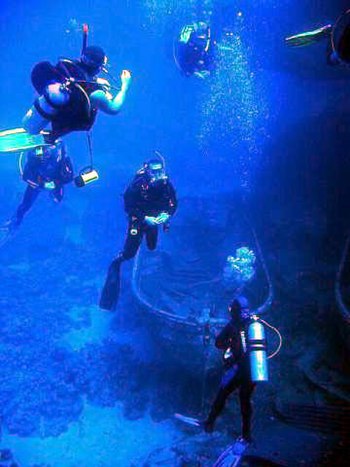| (Photo credit: Wikipedia) |
The divers that we interviewed were all police officers; they trained on a regular basis as a water recovery team. When a need arose, they would leave their normal workday duties and dive.
These divers were involved in cases that included:
* Evidence recovery
* Submerged body recovery, including:
`accidents
`suicide
`victims of a crime
Teams might also participate in:
* Inspecting the hulls of ships in
anti-narcotics operations
* Explosive Ordnance Disposal (bombs)
in anti-terrorism efforts
The team that I interviewed maintained a minimum of three dive members per event.
* A below water surface diver
* An attendant diver who stayed on the surface to assist the underwater diver and to signal/communicate
* A supervisor who works on the surface to direct the operation
Video Quick Study (6:05) Norfolk, England but this is the same information that we received.
Most of the diving investigations are done in highly hazardous environments which might include
* Cold temperatures
* Zero visbility
* Contaminated waters including chemical hazards
* Sharp objects that the divers must feel with their hands since they can not see
* Entanglement and entrapment objects such as submerged trees, rocks, and debris
Video Quick Study (3:32) What it looks like under there.
Video Quick Study (8:21) Difficulties of suiting up, moving, and seeing underwater.
This is picture of one of our instructors, "Cookie." Cookie's technique for keeping the heebie-jeebies at bay while he's groping through pitch-black water for a dead body includes singing as loudly as he can. That's why he makes extra bubbles.
Video Quick Study (3:34) includes information on equipment, sonar, finding a car
| A U.S. Navy diver conducts a dive supporting Infinite Response 09, a bilateral exercise between the U.S. Navy and the naval forces of a Middle Eastern country (Photo credit: Wikipedia) |
* Natural water ways such as oceans, rivers,
and ponds
* Dams
* Caves
* Sewage ponds - there's a nasty plot twist for
you
In some cases sonar is used to reduce diver exposure. This includes side-scan sonar and radial sonar. The sonar can help locate:
* Vessels
* Vehicles
* Planes
* Bodies
* Evidence
Search Patterns:
 |
| graphic from Wikipedia |
Arc Search
* Also known as a pendulum search and a fishtail search
* The diver has a rope that is fed to him by his attendant diver.
* The diver will start on one side of a designated line (such as a shore
line) and swim/grope through the water at the far reach of the line.
* At the end of the arc, the diver turns to go back the other way. The
line is then released at a measured increment, knotted to maintain
a record, and fed to the diver. For example: if the diver is looking for
a bicycle the attendant might release a foot and a half of slack between
arc rotations. If it is a gun, the arcs are much tighter.
* Once the diver has searched the area that can be conveniently reached
with the rope line, the center point is moved to search another area.
* This search works best when the general area is known.
 |
| graphic from Wikipedia |
Circular Search
If the team was out in the water, away from a shore line, they would use a circular grid pattern.
This operates in a similar way as the arc search.
* Fixed central point
* Diver swims 360 degrees before his line is
lengthened
Other Search Patterns
* Jackstay - Has divers swimming a straight line along a shore then moving out a length to swim anotherstraight line.
* Snagline - When an object is large enough, like a car or fridge, a line can be held in parallel swimmers'
hands so that it will catch on the item.
| (Photo credit: Wikipedia) |
Underwater communication
Can take place via
* Line signals
* Communicators
Once an Object is found
* The diver sends up a signal marker
* The GPS coordinates are documented
* The item is elevated using air balloons
Video Quick Study (2:21) You can see the lift bags bringing up a car.
A Body
* Does not lay flat on the floor of the water. The upper half is held at an angle buoyed by air trapped in the
body.
* Will float after about seven days as the body fills with gases
* After several more days as cavities are punctured by fish, birds, and other animals, the body will sink back
into the water.
* The rate of decomposition depends mostly on water temperatures. The colder the water, the longer the
body will remain intact.
* The deceased is bagged underwater.
`This is for the sake of the survivors watching from shore
`This helps to maintain any evidence that will help investigators
Video Quick Study (2:26) Divers talk about their experience and shows arc, and signalling.
Video Quick Study (3:29) Canadian and American divers certify in ice diving. YIPES!
Video LONG Study (47:00) If you are writing a SCUBA scene you may want to spend the time learning
about the problems of hypothermia, dry suit, and choices.







